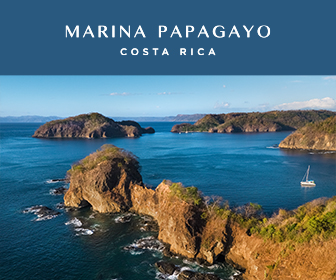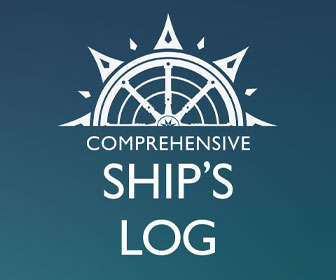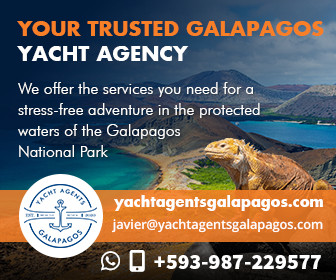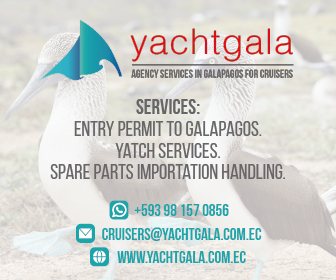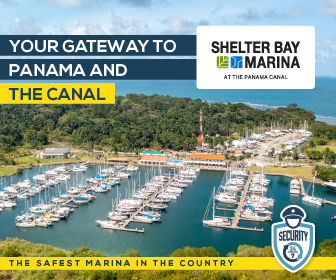Panama Canal Transit Southbound – in detail
Published 12 years ago, updated 5 years ago
In talking with other boaters at Shelter Bay, I found many were anxious and stressed about the transit, not really knowing what to expect. With this in mind, I have written a detailed and extensive (long!) account of what to expect when doing a southbound transit. Perhaps it will help someone have an easier time of it.
David Kory
Panama Canal
Southbound Transit – Atlantic to Pacific
Advance Planning
(See David’s report on his own advance planning here)
Agents
While some people wait until they arrive in Colon to arrange an agent, I found it helpful to solicit a few in advance, asking about fees and services, then choosing one. I emailed him updates as to my expected arrival, and he was ready for me when I got there. He had entered my boat info into the transit system, so I already had a canal ID, and he handled immigration and customs, obtained the cruising permit, and all other required paperwork, and I never had to leave the boat or see an official. He also arranged a transit date of my choosing, handled confirmations when the appointed date arrived and was in constant contact 7 days a week as needed. Well worth a few hundred dollars to me.
Shelter Bay Marina
When arriving in Colon, you can either anchor in “the flats” near buoy “A”, or get a slip in Shelter Bay Marina. The anchorage is inside the main breakwater and protected, but exposed to wakes from the constantly arriving and departing pilot boats, work craft, and large ships heading to the canal entrance. It is about 3 miles from Shelter Bay, a bit long for a dinghy. Thus I stayed in Shelter Bay Marina. Entrance to the marina is at 09.22.26N 79.56.87W.
The marina recommends advance reservations, so I emailed them ([email protected]) about 5 weeks in advance (before departing on my 33-day passage from Buenos Aires). I received an immediate confirmation via email. I then sent updates once a week as to my expected arrival date, which was also immediately acknowledged. When I arrived, I called in on VHF74 after entering the Colon breakwater, about 2 miles from the marina. Several employees carry handheld VHF’s, and all speak Spanish and English, so they were expecting me, and received me at the dock. Registering was quick and easy, and the facilities are modern and very nice.
See separate report for more details on the marina.
Getting Measured
If you have hired an agent, your boat will be visited by an official measurer probably the day after you arrive, between 7 am and 2 pm. Your agent will let you know an approximate time. Only after your boat has been measured can you get a transit date. The measurer showed up, ran a tape measure end to end, and then asked some questions about the boat (engine size and speed) and had me sign a few waivers. You must be able to motor at a minimum of 5 knots for a 2-day transit, and 8 knots for a straight through 1-day transit.
He verified I had the right lines and fenders, or that my agent would be providing them, and that the boat had a head, drinking water, a horn, and an awning or bimini for protection from sun and rain. He also made sure I had 4 line handlers (anybody can do this, friends or crew or other cruisers or local hires), in addition to myself.
He then asked about locking possibilities, and whether I would accept them.
Most common is Center Chamber, which means the boat is in the middle of the lock, using 4 lines- one from each side of the bow and each side of the stern. It is likely that you will be Nested, meaning as many as 4 boats tied side to side, locking together. The largest boat, with the strongest engine(s), goes in the middle and controls the group. If in the middle, you do not have to handle any lines. If on the outside, you would handle the 2 lines on your side of the group. The boats stay nested only between and inside the locks, and not while crossing the lake.
Another possibility is locking alongside an ACP tugboat. This means you are tied to the side of a tugboat, they are tied to the sidewall, and they handle the lines. You may also need to use 2 lines, depending on the position of the tug.
The last option is Sidewall. This means you use only 2 lines and are alongside the wall of the lock chamber. This is not recommended for sailboats locking up, as the water can get turbulent as the chamber fills, and if the boat rocks the mast could strike the wall. Locking down on the sidewall is OK, as the water stays calm when it drains.
The day your boat gets measured, your info will go into the system and you will receive your transit date about 8 pm that same day. Your agent should follow up on this for you. Transit delays can range from a few days to a few weeks and can change rapidly either way. If you are in a hurry and want a guaranteed date, you can choose to pay $2410 additional and use a canal pilot. You will then be scheduled to transit within 2 days. If your boat is over 20 meters (65 feet), they may require you to take and pay for a pilot and to rent an AIS transmitter at a cost of $161.
Lines and Fenders
The canal requires that you have 4 lines, at least 125 feet long, with a minimum diameter of 7/8”, and a maximum of 1 ½ “, with a 3-foot loop at one end (either spliced or a simple bowline will work). All agents, many taxi drivers, and the chandlery at the marina will rent these to you, at a variety of prices. The range I saw was from $100 to $250. If you rent them, find out how to return them before agreeing, as some places (like the chandlery) require you to deliver their lines to their store, while others allow you to just drop them at the Balboa Yacht Club dock. Another option is to purchase your own line, long before getting to the canal, or from a local chandlery. In Panama, a 600-foot spool of 7/8” polypro costs about $250. If you think you would have a use for them later as moorings lines, this could be a good option.
All agents provide plastic wrapped tires as fenders, often included in their fees, but sometimes for a small extra charge. You are not required to use them, but it is highly recommended and will provide you with peace of mind when rafting to other boats or rubbing against the concrete sidewall of the chamber.
Transit Day
There are 3 sets of locks. On a southbound transit, you will enter Gatun locks first, a set of 3 chambers, and lock up to Gatun Lake. On the other side of the lake, you will enter Pedro Miguel locks, and lock down in one chamber, then a short distance later enter Miraflores locks, and lock down 2 chambers. Each chamber changes your altitude about 35 feet.
Typically, handline boats (under 125 feet) depart in the afternoon, lock up to Gatun Lake, spend the night on Gatun Lake, then lock down to the Pacific the next day. It is sometimes possible to depart in the morning (6 am) and go straight through, arriving in the evening, or to depart in the afternoon (3:30 pm) and arrive at 1 am, but your boat must be capable of motoring at 8 knots to do this.
The day before your scheduled transit, you will be given time to receive your canal advisor. All vessels in the canal must have an advisor or pilot aboard. Your agent will let you know the time and should follow up on transit day to ensure it has not been changed.
About 90 minutes before your scheduled advisor time, depart Shelter Bay, and proceed to the staging area, which is next to the yellow buoy “A”, (across from red canal channel buoy 4), at 09.20.60N 79.54.96W, and about 3 miles from Shelter Bay. They ask you to be there one hour early. You can anchor and wait, or just idle around. Your advisor may not be on time, as the canal times are very flexible. You should monitor VHF12 at all times around the canal, and you can call “Cristobal Signal Station” on VHF12 and ask for an update if your advisor is late.
Once the pilot boat has dropped off your advisor, you will proceed to the canal entrance, most likely following a big tanker or something similar. Do not be in a hurry, and do not follow too closely, as the prop wash from the big boats can spin your boat around in circles.
If you are alone, or the controlling boat in a nest, your advisor will tell you when to enter the lock chamber. After the big boat has entered and stopped his engines, his pilot will radio your advisor, announcing it is safe for handling boats to enter.
Proceed slowly towards the lock chamber, and when you get close to the entrance, canal employees on the sides will throw a monkey’s fist attached to a small line onto your boat, one side first, then the other. There is a chunk of lead in the monkey’s fist, so don’t try to catch it. Just grab the small line, and tie a bowline onto the 3-foot loop of your 7/8” line. The canal employees will hold the small line, and walk alongside your boat as it advances into the lock. When you are all the way inside, they will pull the small lines, retrieving your big mooring lines, and place the loops over bollards on the top of the lock chamber.
Once they have done this, your 4 line handlers pull the mooring lines tight. If on a sailboat, try to run your stern lines to a jib winch, as this makes it easy to tighten and loosen the lines as needed. When you are secure, the big back doors to the lock will close, and it will fill with water, lifting you some 35 feet. As the boat rises, the mooring lines start to slacken, and you need to continually pull them tight to keep the boat centred and secure.
When the lock is full, the front doors open, and the big ship in front of you will leave. Keep your lines tight! Cleat them, as it takes a while for the big boat to go. He uses his engines to move forward, creating a bit of turbulence. When he gets to the next lock chamber and is secure, he stops his propellers and the pilot again calls to OK movement of handline vessels.
You ease your mooring lines, and the canal employees toss them into the water. You retrieve your lines, which still have the small monkey fist line attached, and start to motor forward into the next chamber, while the employees walk alongside you, holding the small line. When you are in a position in the 2nd chamber, they will pull up your mooring lines, place them on bollards, then the doors close, water fills, and the whole process repeats. Same thing again for the 3rd Gatun lock.
After exiting the 3rd lock, if you are spending the night on the lake, your advisor will direct you to turn immediately left, and anchor near buoy “A”, about 2 miles from the lock, near 09.15.64N 79.54.98W. Your advisor will be picked up, and you will be given a resume time for the next morning when an advisor will return to your boat, probably around 6 am.
Motoring across the lake is simple, as there are about a thousand red and green buoys marking the channel, and range marks for the big boats as well. Keep Red on the Right going from Gatun locks to Pedro Miguel locks, but after that, it is Green on the Right as you exit into the Pacific.
Locking down is the same as locking up, except with less turbulence. Instead of tightening the lines as you rise, you will be easing them as you lower in the chamber. It is also possible you will be first into the chamber, with a big boat behind you. Pedro Miguel is a single lock, then your motor about a half mile to the Miraflores locks, which has 2 chambers.
After exiting Miraflores locks, you motor towards the Bridge of the Americas, and your advisor will get picked up near the bridge by a pilot boat. After crossing under the bridge, you are on your own in the Pacific. Balboa Yacht Club is the first thing on the left after the bridge, with lots of boats on mooring balls in front, and a long fuel dock in the middle.
A note on feeding your advisor:
The first day, you should just have some snacks available, like cookies or chips or fruit, and bottled water and juice or soft drinks. There is no requirement for anything in particular, but it’s nice to offer a small choice, whether they want it or not.
The second day you should offer more of a meal, such as sandwiches, or whatever else you are preparing for your own crew, along with the same snacks and drinks. It is not a formal event, just a courtesy, but you do need to offer something reasonable. On my straight-through one day transit, my advisors (I had two, as one was a trainee) were very happy with a sandwich, some fruit, chips and cookies.
Hopefully knowing all this in advance will make your transit less stressful and worry free!
Related to following destinations: Panama



